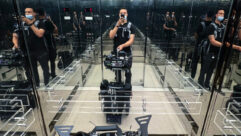
(Photo by: Anne Boccato)
New York (October 29, 2024) — Brett Ainslie mixes films, commercials, sporting events, and reality TV series in Manhattan and its surrounding environs. Media brands that have employed his services include ABC, Bravo, Discovery, Disney, ESPN, Food Network, HBO, and the streaming platform Twitch. For ensuring his clients the utmost in sonic integrity, his personal kit consists exclusively of Lectrosonics Digital Hybrid Wireless — in particular, SRc dual-channel slot-mount receivers paired with SMQV transmitters. When he needs to maximize reception, these are supported by SNA600a dipole antennas.
“The RF environment in New York City is very difficult at the best of times,” explains Ainslie. “Then, when productions come to New York, they often want to shoot in the busiest RF areas like Times Square. I’ve used exclusively the Digital Hybrid stuff for at least the last ten years, and it rolls like a tank.”
The Big Apple is known for a spontaneity that’s practically in the air. Romanticized by tourists and storytellers, this quality manifests in a nerve-wracking way when it comes to the productions Ainslie finds himself mixing. “Unlike how a lot of things are done on projects with more pre-production, I usually don’t have time for much frequency coordination ahead of time,” he says. “It could be ‘man on street’ type interviewing or bouncing between lots of locations for an event like Fashion Week. Even on the rare occasion when we do have a little control over the environment, such as when we had one block closed off for a live-to-tape show, there’s still so much competing RF all around. Lectrosonics Hybrid is the wireless I trust the most to provide the reliability I need.”
In fact, Ainslie credits Lectrosonics’ well-known RF tenacity for allowing him to continue working during the Covid pandemic, which is now infamous for up-ending production workflows. “I worked on a Hallmark film called Holiday in Harlem where they were shooting inside and outside a brownstone,” he recalls, “and my sound cart was outside on the sidewalk, along with the entire ‘video village’ where the director’s monitors are set up. I set up the SNA600 antennas on my transmitter end for my camera hops, boom operator’s, and director’s feed, and I never had to worry about dropouts. The work setup was something similar on any film or show I did during Covid, and the Digital Hybrid gear always performed flawlessly.”
Car-to-car recording adds New York traffic to Ainslie’s list of nail-biters — or rather, factors that would be if it weren’t for Lectrosonics. “I’ve done Toyota commercials with celebrities,” he explains. “The celebrities are usually in and out, so you can’t just listen to the audio after the fact and call them back in to fix things. You need to be able to monitor the audio live so that if something goes wrong, you can fix it on the spot, and that means you need very good range despite the RF environment changing at the speed of a car.”
Ainslie was able to record continuous, clear audio under such circumstances using a remarkably minimal amount of equipment. “We did one of these Toyota ads outside of MetLife stadium,” he says. “Our follow car was much further away, and we got great signal. Likewise for stuff where they’re shooting the talent getting into a taxi and then we follow. Now, there’s an ideal way to do this where you have antennas rigged on the roof of the car and shark-fin antennas on a nearby follow car, but again, the reality is that we almost never have time to do that. The talent is wearing an SMQV, I have my SRc just on its own whip antennas, and I could be a block or two away outside of Madison Square Garden and still be able to monitor everything without any dropouts in my experience.”
Lectrosonics’ durability has also stood up to Ainslie’s work in sports, where sweat and impact are occupational hazards to the gear. “I did a Million-Dollar Summer Challenge for ESPN,” he says. “We had transmitters on the coaches and referees. I’ve also done feature films including hockey and football. The gameplay was scripted, but the players ramming into each other was real. I actually hid SMQVs in the shoulder pads of the talent to capture those sounds without causing harm or discomfort to talent. We never had a problem.”
“The thing about sound is, I feel like I place a heavy hand on a production but in a way that’s relatively invisible if it’s done right,” concludes Ainslie. “Almost everyone thinks they’d know how to run camera, but almost no one thinks they can run sound. If your work is fast-paced and frenetic, full preparation is a luxury, and you absolutely cannot afford dropouts, Lectrosonics is the best wireless.”
About Lectrosonics
Well-respected within the film, broadcast, and theatre technical communities since 1971, Lectrosonics wireless microphone systems and audio processing products are used daily in mission-critical applications by audio engineers familiar with the company’s dedication to quality, customer service, and innovation. Lectrosonics received an Academy Scientific and Technical Award for its Digital Hybrid Wireless® technology and is a US manufacturer based in Rio Rancho, New Mexico. Visit the company online at www.lectrosonics.com.










